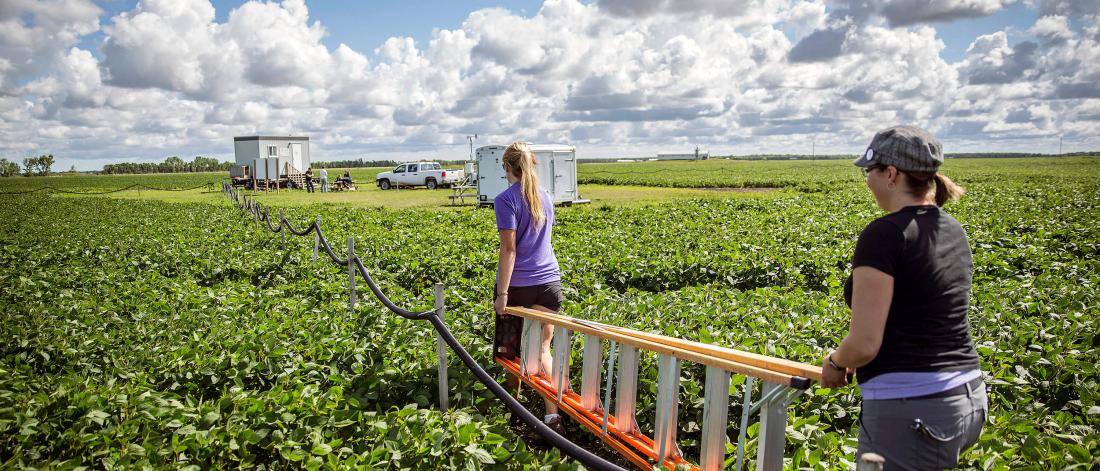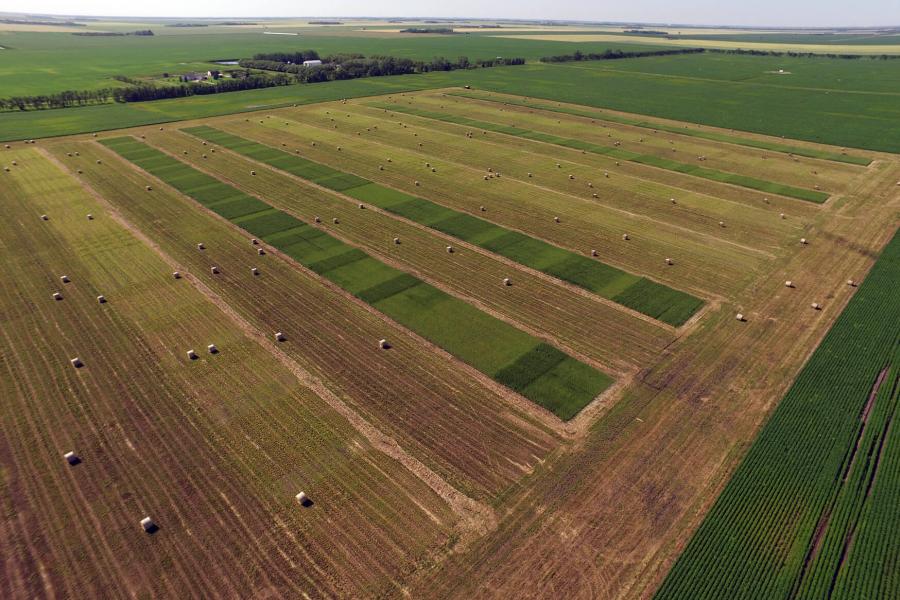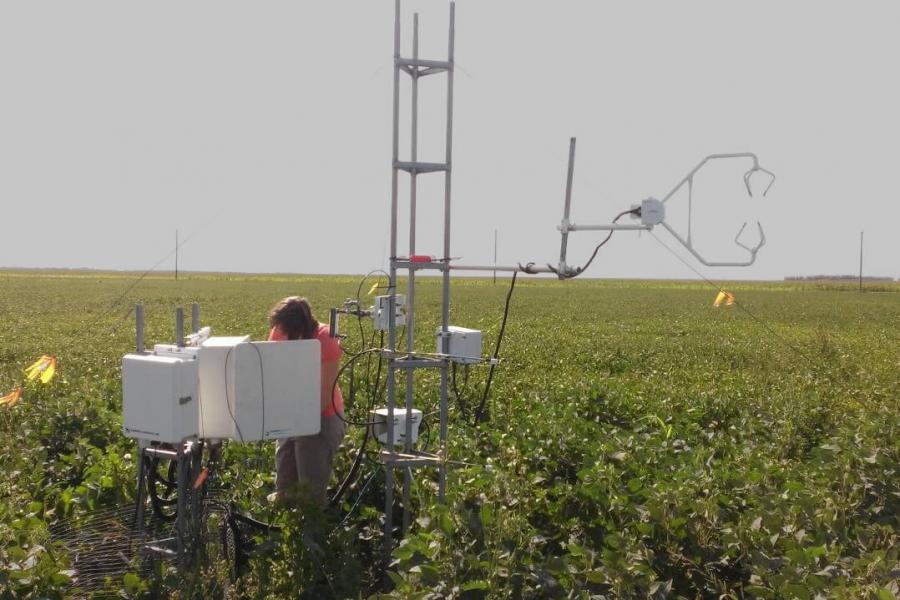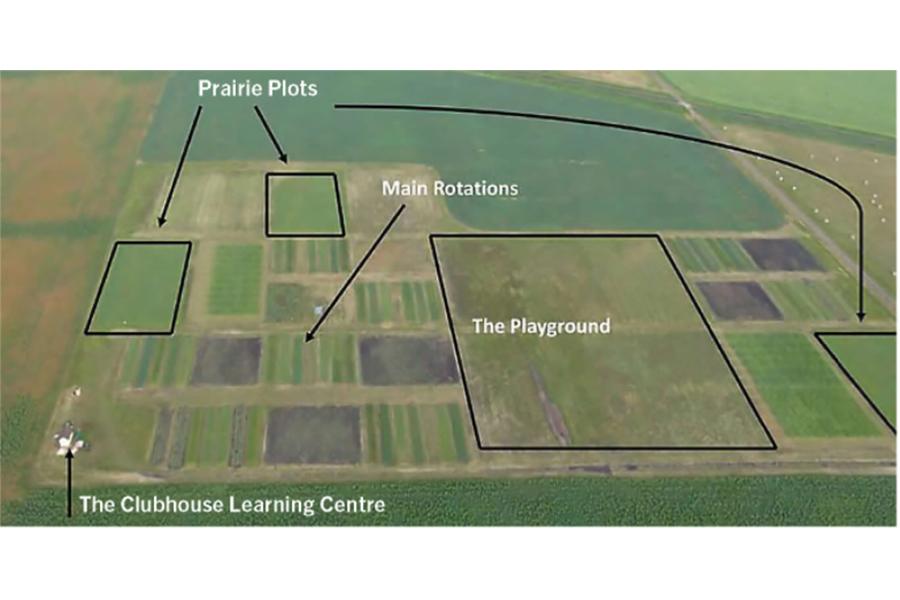Access to a complete range of capabilities
NCLE operates as a virtual centre, connecting researchers, students, industry and government through multi-disciplinary, multi-agency research partnerships. NCLE provides access to the diverse facilities, equipment and land base needed to investigate the environmental, economic and social issues linked to livestock production.
Glenlea Research Station
Research projects developed by the National Centre for Livestock and the Environment (NCLE) scientists and partners come to life at the Glenlea Research Station (GRS). Located 20 minutes south of Winnipeg, the twelve-hundred-acre station is dedicated to research, teaching and outreach activities focused on dairy, swine, beef and field crop production. The station is also home to the Bruce D Campbell Farm and Food Discovery Centre and the future site of a state-of-the-art egg layer research and public outreach facility set to open in 2023.
Read more
The GRS is a functioning model of modern agriculture production where livestock and crop production can be integrated as elements of one system. The station is well-resourced to bring together researchers with a wide array of expertise to connect and engage in multi-disciplinary, multi-agency research partnerships reflective of the NCLE research model. Routinely, animal scientists, plant and soils researchers, entomologists and biosystems engineers come to the GRS to conduct research in one space on a variety of systems-based research projects.
Facilities and capabilities
Dairy cattle - The dairy research facility is a 60-cow operation that features automated feeding and robotic milking. In this facility, researchers can gather data from individual animals that are managed in groups in a free-stall setting. A co-located biosecure metabolism room is fully equipped for comprehensive studies of individual animal nutrient utilization, with an adjacent laboratory for sample processing and storage.
Beef cattle - The beef cattle research infrastructure includes both a pasture environment and partially covered pens equipped with GrowSafe feeding system which facilitates measurements of individual animal intake and feeding behaviour. Beef cattle research activities at Glenlea are focused on forage-based production systems, nutrient metabolism, GHG mitigation and more.
Novel grazing studies, including the use of perennial grains as a dual-purpose crop, as well as corn grazing are conducted in replicated paddocks on site.
Swine - The swine research facility consists of a 150-sow farrow to finish operation. The production spaces mirror commercial operations with sow group housing, but on a smaller scale. Researchers working here have access to breeding, gestation, farrowing rooms with electronic feeders plus nursery and a grower/finisher room where the animals are fed ad lib. All spaces have enrichment. The facility is well suited for research that explores topics in feeding strategies, animal health and well-being, pest and disease prevention and mitigation, and animal housing environments.
Laying hens - The Manitoba Egg Farmers Learning and Research Centre, constructed with funding from Manitoba Egg Farmers and the governments of Canada and Manitoba, is the most modern egg/layer research, education and training facility in all of Canada with an unparalleled capacity to showcase modern animal agriculture to the public.
Feedmill - The feed processing facility provides researchers with the capacity for custom on-site small-batch blending and processing of feedstuffs to investigate novel feed ingredients, ingredient processing and diets.
Manure processing - The station’s Agricultural by-products Processing Research and Demonstration facility includes manure processing, separation and composting equipment to investigate novel concepts in manure management including research on GHG mitigation, nutrient composition and value-add manure processing.
Field sites - The GRS 968 acres of crop land supports several long-running field research programs and provides feed for animals at the station.
All facilities at the GRS are also important for student training at the undergraduate and graduate level in the Faculty of Agricultural and Food Sciences as well as students in the Agriculture Diploma Program
Bruce D. Campbell Farm and Food Discovery Centre
Co-located at the Glenlea Research Station is the Farm and Food Discovery Centre, a hands-on interpretive facility that allows visitors of all ages to explore how food is grown, raised, and processed in Canada. The Centre’s exhibits, public programs and events explore modern farming, livestock, crops, food production and the science and technology that provides healthy, sustainable food for Manitoba and the world. The Centre’s vision is to make learning about agriculture informative, meaningful, engaging and fun!
Contact
Jay Bourcier, Operations Manager
Glenlea Research Station
Phone: 204-712-6000
Email: Jason.Bourcier@umanitoba.ca
Long-term field sites
Field Research Site NCLE long-term field laboratory and archive
Since 2007, a multidisciplinary team has used this site to compare how annual and mixed cropping systems respond to different types of manure and manure management practices. The goal is to reveal how these responses change over time, and how the interplay of crops and manure can be optimized for best crop growth and minimal loss of nutrients.
Approach
The field laboratory is driven by a team of plant, animal, soil and microbiology scientists. Their studies have moved through three phases:
- From 2007 to 2015, the team compared outcomes when manure is applied either annually, at rates to meet crop N requirements, or intermittently, at rates to match crop P removal over several years
- In the second phase, the scope expanded to measure the capacity of the manured soil to continue to release plant-available nitrogen, phosphorus and other essential nutrients after manure applications stop and how this affects crop yield.
- In the third phase, now underway, research at the site has moved into the realm of soil health improvement. The team is exploring how a suite of soil-building practices can improve nitrogen uptake, phosphorus draw-down, carbon retention and additional soil health indicators while also reducing greenhouse gas emissions.
With 144 plots, the 17-hectare site is designed for drop-in studies within the existing study design. Researchers can access an extensive archive of empirical data and samples dating back to 2007, including more than 10,000 samples of plant tissue, soil, manure and DNA, and a database of more than 50,000 sample analysis values.
Why it's important
While manure provides many essential nutrients for crop growth, its nutrient availability can be difficult to predict. Manure's impact also changes over time, and with different soil types and cropping systems. The field laboratory leverages the important element of time to build a better understanding of these factors, often working in tandem with Trace Gas Manitoba and long-term organic/conventional studies based at the Glenlea Research Station.
Armed with more long-term data, farmers and regulators can manage manure for best returns and minimize the potential for greenhouse gas emissions, surface run-off and groundwater contamination.
The laboratory also encourages collaboration among researchers. The rich archive of data and sample provides common benchmarks for study and the foundation to answer new questions as knowledge grows.
Notable findings at the field laboratory to date
- Liquid pig manure is an excellent source of readily available N, generating yields similar to those achieved with synthetic fertilizer.
- Manitoba’s traditional formula for calculating manure application rates can greatly overestimate the amount of N available in solid manures in the year of application.
- Annual manure applications create a reserve of soil N that gradually improves yields over time. The positive effect can continue years after annual manure applications cease.
- Build-up of and draw-down of P in soil depends greatly on the type and amount of manure applied, as well as on growing conditions, manure N availability and soil moisture.
Contact
Dr. Mario Tenuta, professor in applied soil ecology and Industrial Research Chair (IRC) in 4R Nutrient Stewardship
Department of Soil Science, University of Manitoba
Phone: (+001) 204-474-7827
Email: Mario.Tenuta@umanitoba.ca
Field Research Site TGAS continuous GHG monitoring system
Trace Gas Manitoba (TGAS MAN) is the longest running site in the world providing continuous measurement of major greenhouse gas emissions from an agricultural field. By monitoring the corresponding weather and field conditions, it provides a well-rounded picture of how greenhouse gas emissions affected by farming practices and climate.
Approach
TGAS MAN was created as part of NCLE in 2005 to fill an important gap in the study of major greenhouse gases emitted from agricultural soil. Unlike traditional sampling methods, the system directly measures emissions all year round, using a Tunable Diode Laser trace gas analyzer that is permanently housed in an insulated trailer at the junction of four experimental plots.
The TGAS-MAN field site consists of four 200m x 200m (4-ha) experimental plots arranged in a 2×2 grid within a larger 30-ha farmed field. Each plot includes a micrometeorological station which monitors several environmental conditions and, most importantly, sends gas samples every two hours to a tunable diode laser absorption spectrophotometer (Campbell TGAS100A) trace gas analyzer to quantify N2O and CO2 emissions from soil, every day, all day, since 2005.
While measuring greenhouse gas emissions, the site also monitors the corresponding environmental conditions:
- Throughout the growing season, field conditions are monitored and analyzed for moisture content, nitrate and ammonium content.
- Every hour between 8 a.m. and 8 p.m., the TGASCam takes photos to record crop development and height and snow pack depth. These images are uploaded to the TGAS server.
- Biomass samples are collected annually at harvest and analyzed for yield and total carbon and nitrogen content.
TGAS MAN provides open access to flux gradient micrometeorological data archived from 2006-2016.
During the first 8 years short-term projects involving experimental manipulation of tillage intensity, annual vs. perennial cropping systems and timing of fertilizer application were conducted at the site. While monitoring continued under conventional farming practices from 2013-2018, no studies were conducted to allow plots time to recover. Since 2018, TGAS MAN has been focusing on a long-term project investigating the effects of cover cropping on GHG emissions and carbon storage.
Why it's important
It’s widely accepted that improved management can reduce agriculture-related greenhouse gas emissions while reducing costs and improving soil fertility. But by how much? What biological processes are involved? How can we prolong the benefits provided by forages and perennial grains as crops are rotated?
The answers to these questions can be elusive because greenhouse gas emissions are very episodic and can be missed using traditional sampling methods. TGAS-MAN helps fill the knowledge gap with a multi-faceted monitoring system that is easier to deploy, less labour-intensive and in operation all year round.
Notable findings at TGAS MAN to date
Up to 200 kg of nitrogen per hectare can be fixed by alfalfa every year without producing nitrous oxide.
Perennial legume forage reduces loss of carbon from soil, but some of this gain is lost soon after transition to annual cropping.
The TGAS site is extensively used for field days, workshops and tours so that the latest understandings can be shared with producers, agronomists, students, educators, regulators and special interest groups.
Visit the TGAS MAN website to learn more of the TGAS Origin Story, Site and Infrastructure, Phase 1 and Phase 2 research periods, and Support and Funding Sources.
Contact
Dr. Mario Tenuta, professor in applied soil ecology and Industrial Research Chair (IRC) in 4R Nutrient Stewardship
Department of Soil Science, University of Manitoba
Phone: (+001) 204-474-7827
Email: Mario.Tenuta@umanitoba.ca
field research site Glenlea long-term rotation study
Started in 1992, the Glenlea long-term rotation is the oldest organic field crop study in Canada. Since its inception, it’s become an important component of many research programs, yielding findings that help organic farming become more productive and sustainable. Over 2,000 visitors have come to explore this invaluable site.
Approach
Over the past three decades, this study has focused on two dimensions – information farmers can use today, and monitoring of the system ecology over the long-term. A high priority is placed on student education, including graduate-student-led projects.
The main site of study is the University of Manitoba’s Glenlea Research Station, about 20 km south of Winnipeg.
Glenlea contains two main crop rotations: a grain-only rotation (wheat-flax-oat and soybeans or green manure) and a forage-grain rotation (alfalfa-alfalfa-wheat-flax). Both rotations are managed both conventionally and organically. The organic plots are split: On one half, composted cattle manure is applied to replace exported nutrients, and weeds are controlled using new organic management tools. The other half of the organic plot has no amendments.
The study also includes three one-acre plots of restored prairie grassland, which provide a benchmark to study the question “Can agricultural soils be as healthy as perennial grassland soils?”
Recent areas of study include:
- Based on preliminary work early in the life of the Glenlea study, https://cdnsciencepub.com/doi/abs/10.4141/CJPS09006, we have expanded work to compare organic and conventional in terms of the nutritional quality of crops produced (in collaboration with Dr. Xiaopeng Gao, UM Soil Science).
- Building on our past work on alternative phosphorus sources for organic agriculture https://cdnsciencepub.com/doi/full/10.1139/cjss-2021-0014, we are currently testing a combination of animal manures and “anthronutrients” (nutrients from the urban food system) as a sustainable P source for organic production.
- Based on previous studies on C and N cycling at Glenlea (https://www.sciencedirect.com/science/article/abs/pii/S0167880917304954; https://www.sciencedirect.com/science/article/abs/pii/S0167880916304868), we are testing methods to make organic farming even more climate friendly (in collaboration with Dr. Mario Tenuta, UM Soil Science).
- Working together with scientists across North America, Glenlea was one of 124 long-term sites to receive a comprehensive soil health assessment (led by the Soil Health Institute). The first paper from the work is now published https://cdnsciencepub.com/doi/full/10.1139/cjss-2021-0104.
- Using knowledge gained in complementary research (https://acsess.onlinelibrary.wiley.com/doi/abs/10.2134/agronj2016.01.0032), we are pushing the boundaries on reducing tillage in organic production.
- We are planning to include Kernza (Intermediate wheatgrass) as a dual-purpose crop (grain; livestock feed; feedstock for biogas production) in the organic system (in collaboration with Dr. Doug Cattani, UM Plant Science).
Local and visiting researchers, together with their students, have built upon findings to create an essential knowledge bank aimed at making organic farming more productive and sustainable. Farmers also work as research partners on several projects, including participatory plant breeding to develop varieties that work specifically for their systems.
Why it's important
The growing base of knowledge developed through the ongoing study helps take the risk out of going into organic production. In addition, the findings provide valuable information to confront issues in conventional farming systems, including herbicide resistance and the need for more precise nutrient management.
As one of the few long-term investigations of its kind, the study is an increasingly important teaching tool and a magnet for graduate students and researchers from around the world.
Notable findings of the rotation study to date
- The risk of herbicide-resistant wild oats can be virtually eliminated by introducing short-term perennial alfalfa hay into the grain-based conventional rotation. It also reduces N fertilizer needs by 40%.
- With regular addition of composted manure, cover crops and perennials, organic systems surpass conventional systems in terms of soil health.
- Organic forage-grain rotations produce alfalfa yields on par with conventional systems. Wheat and flax yields are usually lower but are increasing at a faster rate as researchers figure out the organic system.
- Organic systems release 30% less nitrous oxide per bushel of wheat than wheat grown under conventional systems.
- Organic systems produce a bushel of wheat using 30% less fossil fuel energy than conventional systems.
Knowledge transfer
Students and staff are involved in outreach through field days, webinars, winter meetings and seminars. Recent educational work included two-and-a-half-year program in organic agronomy that attracted more than 150 agronomists from across the Prairies.
Select materials:
Contact
Dr. Martin Entz, professor of cropping systems and natural systems agriculture
Department of Plant Science, University of Manitoba
Phone: (+001) 204-474-6077
Email: Martin.Entz@umanitoba.ca





